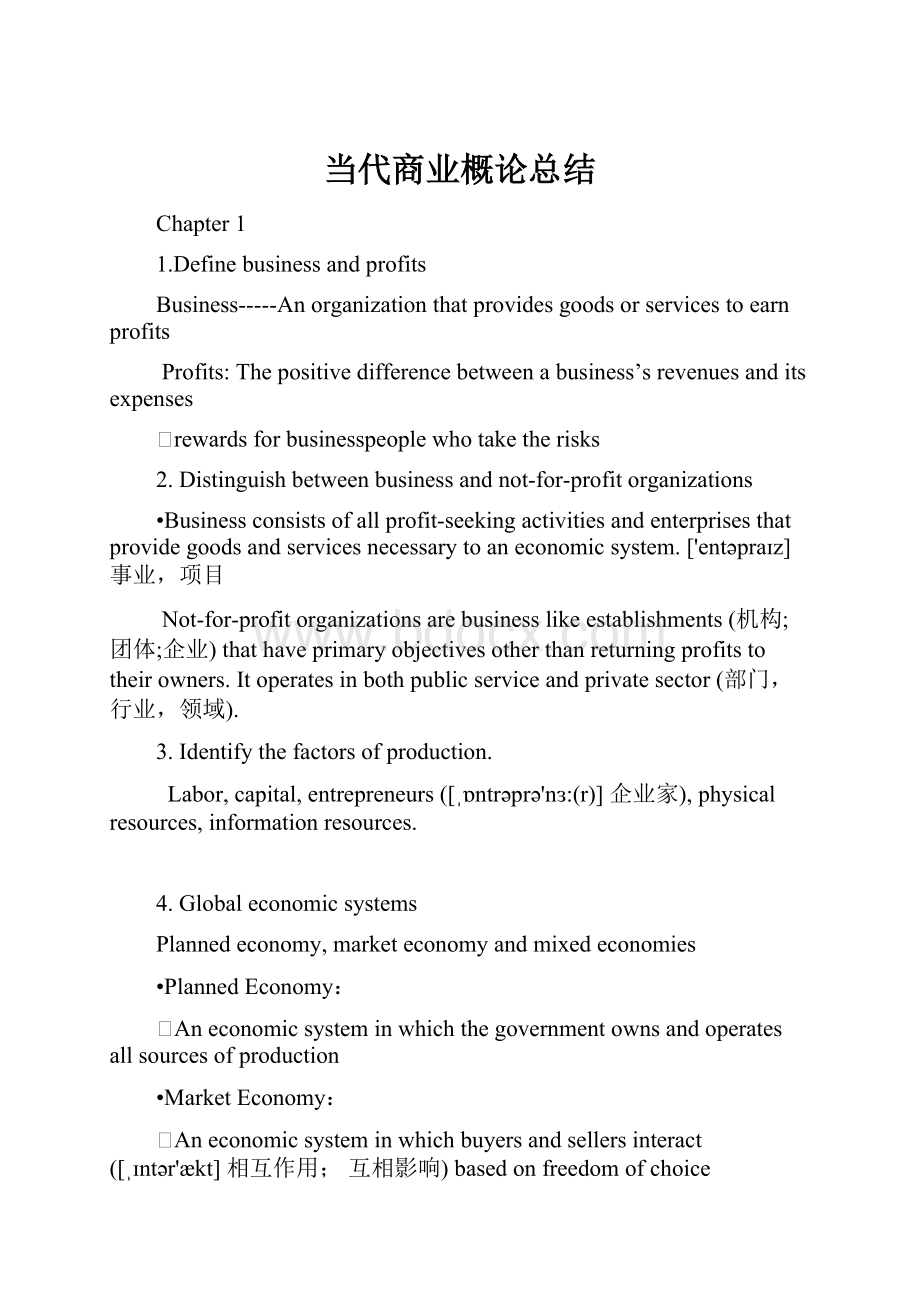当代商业概论总结.docx
《当代商业概论总结.docx》由会员分享,可在线阅读,更多相关《当代商业概论总结.docx(22页珍藏版)》请在冰豆网上搜索。

当代商业概论总结
Chapter1
1.Definebusinessandprofits
Business-----Anorganizationthatprovidesgoodsorservicestoearnprofits
Profits:
Thepositivedifferencebetweenabusiness’srevenuesanditsexpenses
Ürewardsforbusinesspeoplewhotaketherisks
2.Distinguishbetweenbusinessandnot-for-profitorganizations
•Businessconsistsofallprofit-seekingactivitiesandenterprisesthatprovidegoodsandservicesnecessarytoaneconomicsystem.['entəpraɪz]事业,项目
Not-for-profitorganizationsarebusinesslikeestablishments(机构;团体;企业)thathaveprimaryobjectivesotherthanreturningprofitstotheirowners.Itoperatesinbothpublicserviceandprivatesector(部门,行业,领域).
3.Identifythefactorsofproduction.
Labor,capital,entrepreneurs([ˌɒntrəprə'nɜ:
(r)]企业家),physicalresources,informationresources.
4.Globaleconomicsystems
Plannedeconomy,marketeconomyandmixedeconomies
•PlannedEconomy:
ØAneconomicsysteminwhichthegovernmentownsandoperatesallsourcesofproduction
•MarketEconomy:
ØAneconomicsysteminwhichbuyersandsellersinteract([ˌɪntər'ækt]相互作用;互相影响)basedonfreedomofchoice
MixedEconomies:
PlannedandMarket
•Theeconomiesofmostcountriesincludebothplannedandmarketelements.
5.Explainthefactorsthatdrivedemandandsupply.
(1)FactorsDrivingDemand
1)Price
2)Customerpreferencesandincome
3)Pricesofsubstitute(['sʌbstɪtju:
t]替代的)andcomplementary([ˌkɒmplɪˈmentri]互补的)items
4)Numberofbuyersinthemarket
5)Consumers’optimismaboutthefuture.
(2)FactorsDrivingSupply
•factorsofproduction(Centralroleindeterminingtheoverallsupplyofgoodsandservicesisplayedbyfactorsofproduction.)
•Otherfactorsliketaxesandthenumberofsupplierswillalsoinfluencethesupply.
6.Describeeachofthefourdifferenttypesofmarketstructuresinaprivateenterprisesystem.
Perfectcompetition,monopolistic[məˌnɔpəˈlistik]competition(垄断性竞争),oligopoly([ˌɒlɪ'gɒpəlɪ]寡头,求过于供的市场情况)andmonopoly([mə'nɒpəlɪ]垄断)
Perfectcompetitionexistswhenallfirmsinanindustryaresmallandthenumberoffirmsislarge.Pricesaredeterminedbymarketforcesassupplyanddemand.
Inmonopolisticcompetition,manysellerstrytomaketheirproductsatleaseseemtobedifferentfromthoseofcompetitors.Productdifferentiationgivessellerssomecontroloverprices.
Whenanindustryhasonlyahandfulofsellers,anoligopolyexists.Theentryofnewcompetitorsishard.Andthepricesofcomparableproductsareusuallysimilar.
Amonopolyexistswhenanindustryormarkethasonlyoneproducer.Asolesupplierenjoysnearlycompletecontroloverthepricesofitsproducts.
Characteristic
Perfectcompetition
Monopolisticcompetition
Oligopoly
Monopoly
Example
Localfarmer
Stationerystore
Steelindustry
Publicutility
Numberofcompetitors
Many
Many,butfewerthaninperfectcompetition
few
none
Easeofentryintotheindustry
Relativelyeasy
Fairlyeasy
difficult
Regulatedbygovernment
Similarityofgoods/servicesofferedbycompetingfirms
Identical
Similar
Canbesimilarordifferent
Nodirectlycompetinggoodsorservices
Levelofcontroloverpricebyindividualfirms
None
Some
Some
Considerable
7.Identifyanddescribethefourstagesofthebusinesscycle.
Prosperity,繁荣;recession衰退;depression萧条;recovery复苏
[prɒ'sperətɪ][rɪˈseʃn][dɪ'preʃn]
8.Explainhowproductivity,price-levelchanges,andemploymentlevelsaffectthestabilityofanation’seconomy.
9.Discusshowmonetarypolicyandfiscalpolicyareusedtomanageaneconomy’sperformance.
MonetaryPolicy货币政策
governmentactionstoincreaseordecreasethemoneysupplyandchangebankingrequirementsandinterestratestoinfluencebanker’swillingnesstomakeloans.
FiscalPolicy财政政策
Governmentinfluenceseconomybyspendingandtaxationdecisions.Governmentusesfiscalpolicytocontrolinflations([ɪn'fleɪʃn]通货膨胀),reduceunemployment,improvethegeneralwelfareofcitizens,andencourageeconomicgrowth.
Chapter2
1.Explaintheconceptsofbusinessethicsandsocialresponsibility.
Businessethicsarestandardsofbusinessconductandmoralvaluesbyemployeesonthejob
Socialresponsibilityreferstotheoverallwayinwhichabusinessattemptstobalanceitscommitmentstorelevantgroupsandindividualsinitssocialenvironments.
2.Describethefactorsthatinfluencebusinessethics,atindividual,organizational,legal,societallevels
Individual:
values,workbackground,familystatus,personality
Organizational:
TopLevelMgmt.Philosophy,theFirm’sRewardSystem,JobDimensions
Environmental:
Competition,economicconditions,social/culturalinstitutions
3.Listthestagesinthedevelopmentofethicalstandards.
Stage1:
Preconventional
Individualismainlylookingoutforhisorherinterest.Rulesarefollowedonlyoutoffearofpunishmentorhopeofreward.
Stage2:
Conventional
Individualconsiderstheinterestsandexpectationsofothersinmakingdecisions.Rulesarerulesarefollowedbecauseitisapartofbelongtothegroups.
Stage3:
postconventional
Individualfollowspersonalprinciplesforresolvingethicaldilemmas.Heorsheconsiderspersonal,groupandsocialinterests.
4.Identifycommonethicaldilemmasintheworkplace.
Conflictofinterest,honestyandintegrity(正直),loyaltyVStruth,whistle-blowing(揭发).
5.Discusshoworganizationsshapeethicalbehavior.
6.Summarizetheresponsibilitiesofbusinesstothegeneralpublic,customers,employeesandinvestors.
ResponsibilitiestotheGeneralPublic
a)PublicHealthIssues
b)ProtectingtheEnvironment
Greenwashing:
Usingadvertisingtoprojectagreenimagewithoutsubstantiallyalteringprocessesorproducts
Recycling—reprocessingofusedmaterialsforreuse
c)DevelopingtheQualityoftheWorkforce
d)CorporatePhilanthropy([fɪ'lænθrəpɪ]慈善事业)
ResponsibilityTowardCustomers
ConsumerRights,UnfairPricing,EthicsinAdvertising
ResponsibilityTowardEmployees
WorkplaceSafety;QualityofLifeIssues…….
ResponsibilityTowardInvestors
Improperfinancialmanagement;Checkkiting空头;Insidertrading;
Misrepresentationoffinances
7.ExplaindifferentstancesinCSR
Chapter3
1.Identifytheindustriesinwhichmostsmallfirmsareestablished
Services服务业,retailing零售业,construction建筑业,wholesaling批发,financeandinsurance金融保险,manufacturing制造业,transportation运输.
2.Comparetheadvantagesanddisadvantagesofsmallbusinesses.
Smallfirmscanoftenoperatewithgreaterflexibilitythanlargercorporationscanachieve.Thisflexibilityallowssmallbusinesstodevelopinnovativeproducts,lowercosts,providesuperiorcustomerservice,andfillisolatedniches.['aɪsəleɪtɪd]偏远的[nɪtʃiz]商机
However,smallbusinessalsomustoperatewithfewerresourcesthanlargecorporationscanapply.Asaresult,theymustsufferfromfinanciallimitationsandmanagementshortcomings.Taxesandgovernmentregulationcanalsoimposeexcessiveburdensonsmallbusiness.
3.Explainhowfranchisingcanprovideopportunitiesforbothfranchisorsandfranchisees(被特许人).
Franchiseesbenefitfromtheparentcorporations'experienceandexpertise.Thefranchisermaypickthestorelocation,negotiatethelease,purchaseequipment,andsupportfinancing.Franchisingoffersthebenefitofbrandrecognition,whichcanmakeiteasiertoattractcustomersandreducethecostsofadvertisingaswellasincreasethelikelihoodofsuccess.
4.Definethetermentrepreneuranddistinguishamongentrepreneurs,small-businessowners,andmanagers.
Entrepreneur:
Businesspersonwhoacceptstherisksandopportunitiesinvolvedincreating,operatingandgrowinganewbusiness
SmallBusinessOwner:
Doesnothaveplansforgrowth.
5.Startingandfundingasmallbusiness
•StartingfromScratch[skrætʃ]从零开始;从头做起;白手起家
ØDisadvantage:
Higherriskofbusinessfailure
ØAdvantage:
Avoidsproblemsofanexistingbusiness
•BuyinganExistingBusiness
ØSomeprefernottoassumetherisksofstartinganewfirm
Franchising
vAnotherlessriskywaytobeginabusiness
a)Cf.equityfinancinganddebtfinancing
6.Identifythreedifferenttypesofentrepreneurs.企业家
•Classicentrepreneurs—personwhoseesabusinessopportunityanduseresourcestotapthatmarket.
•Intrapreneur—personwhodevelopsinnovationswithinalargeorganization.[ɪntræprə'ni:
ɜ:
]公司内企业家,内部创业者
•ChangeAgent—managerwhotriestorevitalizeanestablishedfirmtokeepitcompetitive.[ˌri:
'vaɪtəlaɪz]vt.使恢复元气;使新生;使复兴
7.Identifypersonalitytraitsthattypicallycharacterizesuccessfulentrepreneurs.
Successfulentrepreneursmayhaveseveraltraits,includingvision,highenergylevel,needtoachieve,self-confidenceandoptimism,toleranceforfailure,creativity,toleranceforambiguity(含糊),andinternationallocusofcontrol.
1)Areresourcefulandopen-minded足智多谋,心胸开阔
2)Areconcernedaboutgoodcustomerrelations良好顾客关系
3)Desiretobetheirownboss
4)Candealwithuncertaintyandrisk
5)Relyonnetworks,businessplans,andconsensus(共识)
8.Summarizethethreebasicformsofbusinessownershipandtheadvantagesanddisadvantagesofeachform.
1)SoleProprietorships(所有权)个人独资企业
Disadvantages:
•UnlimitedLiability(majordrawback)
•Limitedresources
•Limitedfundraisingcapability(有限的融资能力)
•Lackofcontinuity
Advantages:
•Freedom
•Simpletoform
•Lowstartupcosts
•Taxbenefits
•Don’thavetosharetheprofits
2)Partnerships合伙企业
Inmostcases,partnerssharetheprofitsequallyorinproportiontotheirinvestment.
Silentpartner:
investfundsbutplaynoroleinitsmanagement
Disadvantages:
•Unlimitedliability
•Disagreementsamongpartners
•Lackofcontinuity
•Ownershiptransfer
Sweatequity:
investnothingbutprovideallthelabor
Advantages: